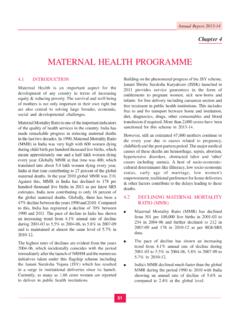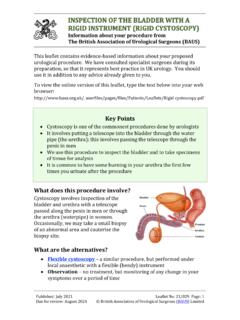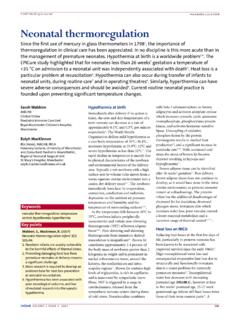Transcription of Post-COVID Elective surgery Recovery & Transformation
1 1 Post-COVID Elective surgery Recovery & Transformation GIRFT guidance for clinical and operational practice guidance for patients with hip and knee pain requiring joint replacement surgery November 2020 Contents 1. Introduction Page 2 2. Key recommendations Page 4 3. First presentation Page 6 4. Surgical review or assessment Page 7 5. Pre- surgery education and preparation Page 9 6. Pre-operative assessment and preparation Page 10 7. The day of surgery Page 12 8. Anaesthetic guideline Page 14 9. Joint replacement prosthesis and surgical technique Page 15 10. Venous thromboembolism prophylaxis Page 16 11. Inpatient management Page 16 12. Follow up procedures Page 18 13. Standards for good governance and efficiency metrics Page 21 14. Transformation & Recovery Page 22 15. Acknowledgements Page 23 16. References Page 24 17.
2 Appendices Page 25 2 1 Introduction Getting It Right First Time (GIRFT) is an NHS improvement programme led by frontline clinicians designed to improve the quality of care within the NHS by reducing unwarranted variation. Sharing best practice nationally continues to identify change to improve patient care and patient outcome. It drives efficiencies to reduce unnecessary interventions to deliver cost savings. Over the past few months, the NHS has seen an unprecedented pace of Transformation as a result of covid -19. The Trauma & Orthopaedic community was at the forefront of implementing rapid collaborative change and innovations as a response to the covid -19 pandemic where Elective and trauma services were significantly impacted. It is recognised that positive practice has arisen during this period all over the country1,2,3 especially in areas of Outpatients, Diagnostics, Management & Governance of minor injuries, and medical rotas that will support improved outcomes and patient experience to become part of the new normal and can be applied for the betterment of the NHS.
3 With orthopaedic services making up more than 25% of all surgical interventions, the service is particularly impacted by the cessation of Elective activity. This has created new challenges: higher numbers of patients on the waiting list, reduced theatre productivity, longer waiting times and managing services whilst maintaining safety for patients and staff in light of the pandemic. This will mean every opportunity will need to be taken to improve efficiency. As we now look to restarting Elective services the GIRFT programme recommends the use of this unique opportunity to combine the GIRFT datasets and review the service on the basis of recent experience. This will transform the way in which services are designed, coordinated and delivered as the NHS moves into the Recovery and Transformation phase post covid -19, and will improve the quality and standard of care for patients. GIRFT has brought about significant qualitative and quantitative improvement in orthopaedic surgery4, 5.
4 In its drive for continuous improvement it recommends using the greater potential to utilise networks, theatre space and resources to maximise productivity within the NHS regions and minimise disruption as a result of covid -19. Breaking down barriers between organisations and teams will be crucial to delivering this. To fully harness this opportunity to embed positive change, it is crucial the programme moves at pace, following the lead set by units across the UK. The GIRFT orthopaedic pilot project will harmonise policies (as below) and the experience and learnings will be shared nationally (proposed GIRFT QI academy). 3 The GIRFT team are already underway with the development of the model, data provision and best practice development. The GIRFT programme believes that in order to raise the standards across the board the current top decile performance nationally should now be set as the GIRFT standard for all services within the NHS as they incrementally restart following the covid crisis.
5 By setting this high standard for care and reducing any unwarranted variation there is a potential to further improve metrics detailed in section and appendix1 that would result in: Release of bed days Reductions in readmissions Enhanced patient experience Improve patient flow by increasing capacity of emergency beds & trauma theatres Make Emergency departments more efficient Improvement in training standards Improved long term survivorship of implants Procurement savings GIRFT will be expecting units to deliver further innovations and improvements that will be captured and incorporated into regular iterations of this document to enable the rapid dissemination of learning nationally. This initiative aims to initially review clinical pathways for orthopaedic conditions in its London hub and develop a best of the best standardised clinical pathway to improve the experience and care for those patients who will need Elective surgery in the shortest possible time, without compromising safety.
6 As the project rolls out nationally it is anticipated that there will need to be some flexibility to accommodate local and regional requirements. The GIRFT guide provides the integrated care systems with a sequential process based on best practice, national guidelines and expert decision making for the management of all patients referred with joint pain that resultantly require surgical intervention (including joint replacement surgery ). The GIRFT hot and cold site pilot programmes5 have shown that wherever possible it is critical that inpatient Elective work is centralised to one geographical area or site with day surgery cases done in dedicated day surgery6. The Elective areas should be covid -19 protected, equipped with ring fenced Elective orthopaedic base, laminar flow theatres, appropriate plans for medical, diagnostic and specialty support including immediate back up high dependency services to patients who are higher risk as per the recommendation of the Faculty of Intensive Care Medicine7 In recent years there has been progress in hip and knee replacement enhanced Recovery with units having implemented some or all components of enhanced Recovery .
7 There still is variation in length of stay with patients been discharged variably from on day 0 (day 4 case) to units having mean inpatient stay of more than 5 days. There must be an emphasis on enhanced Recovery programmes that will improve patient flow and reduction in total use of bed days. All patients who have been listed for surgery should have the principles or culture of enhanced Recovery applied as part of a formal programme with optimum post-operative support in the community. Shared decision making8 should be built into points along the care pathway to encourage patient choice and participation. This is particularly relevant when people face high value decisions where the choice can have a significant impact (positive or negative) on their lives. At these decision points , options should include medical and conservative treatments, symptomatic management and (where relevant) the option of psychosocial/community support.
8 (Appendix 5) During the covid crisis it is important that all pathways are covid secure and follow Infection prevention guidelines. Pathways should be reviewed and evaluated 2 Key Recommendations General The Integrated Care System (ICS) should create covid -19 protected zones where Elective surgery is performed. Inpatient Elective work is centralised to these protected zone(s). All patients should be admitted to dedicated ring fenced orthopaedic Elective wards and all support services available during operating hours (incl. x-ray and path labs). Patients with complex medical needs may need a different pathway if all support services are unavailable. Each patient pathway that involves Elective surgery should have the principles or culture of enhanced Recovery and emphasis must be placed on such a programme The integrated care system should establish systems for advice and guidance such that primary care networks and secondary care work in conjunction to improve communication and streamline the pathway for patients.
9 In line with the NHS Long Term Plan the ICS should encourage virtual consultation and improve patient convenience, specialist accessibility and ease clinical space shortage. MSK specialist triage referral management system is in place with clear clinical pathways and a referral management plan. Regular job planned multi-disciplinary team meetings with clear terms of reference about decision making and governance. ICS should put resources into patient education programmes ( Joint School). The integrated care system (or the region) should have a virtual PTL per sub speciality that will add further intelligence to the demand and capacity plans The integrated care system (or the region) should consider a clinician passport such that clinicians can move between hospitals. There should be a standardised clear policy to assess clinical harm if patients 5 cannot be operated or followed up with in line with the nationally mandated RTT standard.
10 Comprehensive Elective service should be incrementally provided over 7 days where possible, after taking into consideration issues with staff wellbeing and recruitment. The ICS should model the capacity they will generate by peer reviewing themselves within the top decile. The ICS should have a standardised WHO surgical safety checklist protocol across all its hospitals to ensure patient safety. The ICS should have a patient level information and costing system in place such that true costs of a procedure are easily available for comparison. Specialist First OP appointment should occur within six weeks of routine patient referral. Shared decision making should be built into points along the care pathway. Patients should have single point of contact to advise of illness or cancellation (Consider care coordinators as described in appendix 6) Consent clinics in place at around the time of the preoperative assessment. Pre-assessment teams should be multidisciplinary and include representation from Clinical Pharmacy and Pain Management.








